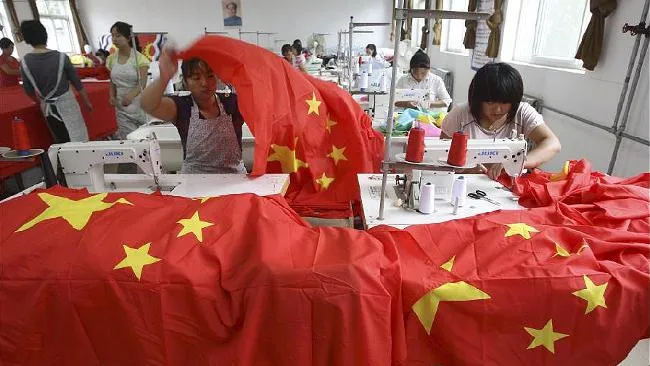| Waiting for the growth slowdown Our basic view of the economy is that the government has aggressively tightened monetarypolicy over the course of the last few months. Tightening works with a lag, so while growth
momentum was still very strong in 1Q11, we expect it to slow towards mid-year and into3Q11. We would expect this slowdown to be manifested in the PMI‟s falling below 50, a
downturn that is reflected in our below-consensus forecast for GDP of 8.5-9.0% this year.This slowdown should take some of the pressure off inflation, particularly towards the end of
3Q11. With the growth slowdown also likely to result in an unwelcome rise in the tradesurplus, we would expect an easing of policy later in the summer, putting a floor under growth
into 2012. This analysis might seem surprising, given that benchmark rates in real terms remainnegative. But for credit growth in China, benchmark rates aren‟t important, we believe. Rather
than raising rates in the hope of dampening credit growth, policymakers in China act todetermine directly how much the banks can lend. On the one hand, regulators tell banks they
can‟t issue loans. On the other, they use sterilisation – hikes in the Reserve RequirementRatio (RRR) and sales of PBC bills – to take liquidity away from banks so they don‟t have the
wherewithal to be able to lend. These measures have helped lending growth to slow from19.9% YoY at the end of 2010 to 17.5% now. That might not sound like much of a slowdown. However, during the same period, commodityprices have been rising, a development which reduces the purchasing power of the limited
amount of loans the government makes available. We estimate that, in real terms, lending growth has slowed more dramatically than at any other time in recent years. Nowadays there
are other sources of capital for borrowers, such as trust companies and the capital markets.But these don‟t seem to be filling the hole left by slower bank lending. If they were, and the
supply of money in the economy was still abundant, the price of money wouldn‟t be changing.But market-driven interest rates have all risen, in the form of higher SHIBOR, increases in the
proportion of loans that banks make above the benchmark (showing that banks have pricingpower), and reports that kerb market rates have risen to record highs. On some measures,
credit conditions look tighter than they were during the credit crunch of 1H08. |




![SBR 5 Lorem Ipsum News 2 [8 May]](https://cmg-qa.s3.ap-southeast-1.amazonaws.com/s3fs-public/styles/exclusive_featured_article/public/2025-05/a_hand_pointing_to_a_futuristic_technology_5b87c9d0e3_3.png.webp?itok=M3Hf-9XR)
![SBR 4 Lorem Ipsum [8 May Top Stories]](https://cmg-qa.s3.ap-southeast-1.amazonaws.com/s3fs-public/styles/exclusive_featured_article/public/2025-05/a_hand_pointing_to_a_futuristic_technology_5b87c9d0e3_2.png.webp?itok=2m5Wl0MX)


![Exclusive three SBR 12 Lorem Ipsum [8 May]](https://cmg-qa.s3.ap-southeast-1.amazonaws.com/s3fs-public/styles/exclusive_featured_article/public/2025-05/a_hand_pointing_to_a_futuristic_technology_5b87c9d0e3_11.png.webp?itok=8kn_UIfA)
![SBR 3 Lorem Ipsum [ Exclusive 2]](https://cmg-qa.s3.ap-southeast-1.amazonaws.com/s3fs-public/styles/exclusive_featured_article/public/2025-05/a_hand_pointing_to_a_futuristic_technology_5b87c9d0e3_1.png.webp?itok=YCyjLegJ)
![SBR 2 Lorem Ipsum [8 May]](https://cmg-qa.s3.ap-southeast-1.amazonaws.com/s3fs-public/styles/exclusive_featured_article/public/2025-05/a_hand_pointing_to_a_futuristic_technology_5b87c9d0e3_0.png.webp?itok=_cKD-29o)

![Video [Event News]](https://cmg-qa.s3.ap-southeast-1.amazonaws.com/s3fs-public/styles/event_news_featured_article/public/2025-05/screenshot-2025-05-08-at-4.58.53-pm_0.png.webp?itok=Kud35sMs)
![Event News SBR 9 Lorem Ipsum [8 may]](https://cmg-qa.s3.ap-southeast-1.amazonaws.com/s3fs-public/styles/event_news_thumbnail/public/2025-05/a_hand_pointing_to_a_futuristic_technology_5b87c9d0e3_8.png.webp?itok=DTh_dbYp)
![Event News SBR 9 Lorem Ipsum [8 May]](https://cmg-qa.s3.ap-southeast-1.amazonaws.com/s3fs-public/styles/event_news_thumbnail/public/2025-05/a_hand_pointing_to_a_futuristic_technology_5b87c9d0e3_7.png.webp?itok=vzDAzb6V)
![Event News SBR 8 Lorem Ipsum [8 May]](https://cmg-qa.s3.ap-southeast-1.amazonaws.com/s3fs-public/styles/event_news_thumbnail/public/2025-05/a_hand_pointing_to_a_futuristic_technology_5b87c9d0e3_6.png.webp?itok=jvHFc4P6)
![Video [Event News]](https://cmg-qa.s3.ap-southeast-1.amazonaws.com/s3fs-public/styles/video_thumbnail/public/2025-05/screenshot-2025-05-08-at-4.58.53-pm_0.png.webp?itok=yZnI0YBb)
![Video 1 SBR [8 May]](https://cmg-qa.s3.ap-southeast-1.amazonaws.com/s3fs-public/styles/video_thumbnail/public/2025-05/screenshot-2025-05-08-at-4.58.53-pm.png.webp?itok=9AAeRz_k)

 Advertise
Advertise

